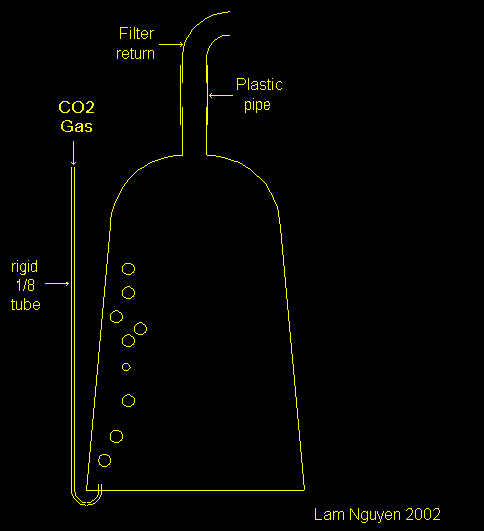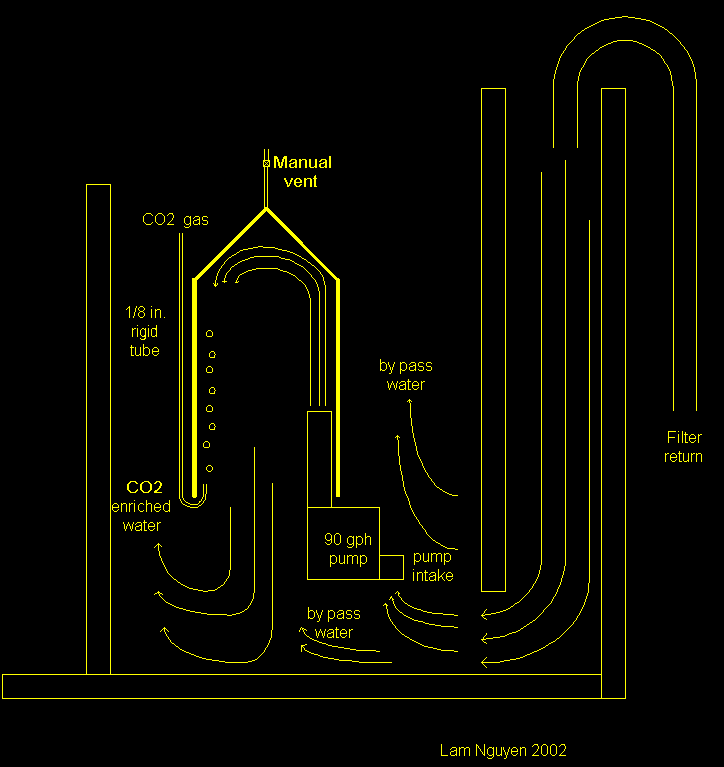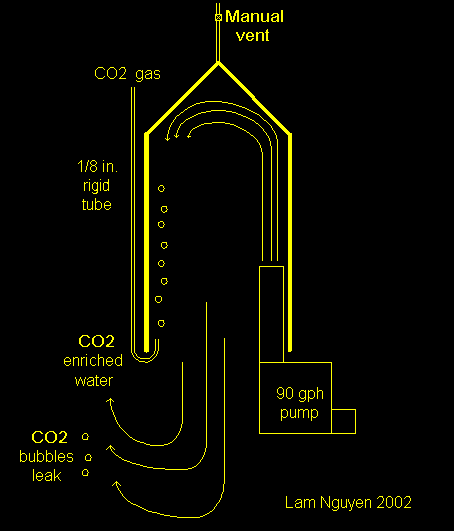| |
With this CO2 reactor design I don't have to worry about CO2 dumping. Actually,
I never have it happened to me before. I changed the CO2 tank when the pressure
dropped to 400 PSI. If the CO2 dumping did occured, the CO2 reactor chamber
will over fill quickly and spill excess gas before it has a chance to dissolve.
The only way for the CO2 dump to have any chance of doing any real damage is
cause by the needle meter valve. If the needle valve slow down the rate of the
CO2 gas then that would be a problem. This CO2 reactor designed to dissolve
CO2 gas into water fairly quickly. It is able to dissolve CO2 gas with a bubble
rate of 40 bubbles a second. This is an eye ball estimation only. I could not
count the bubble that fast nor does the bubble actually form at about 1/8 inch
diameter at that rate. The rate I feed it into the reactor was about four 3/4
inch diameter bubbles per second. At this rate of incoming gas, the CO2 gas
pocket in the reactor chamber remain constant. The pH would drop very rapidly
to 6.0. But remember that my CO2 reactor located in an external service tank.
The external service tank contains about 2.5 gallons. So even when the pH in the
service tank drop to 6.0, it would be some time before the pH in the main tank
begin to drop.
I set my regulator at 2 PSI. So if the CO2 dump occurs, the initial pressure
would be about 350 to 400 PSI. At that pressure the feed rate would be very
much faster that normal and spillage would happen. The damage would have to be
near the end of the dump where the pressure drops to near 30 to 40 PSI. At that
pressure, I believe the dissolve rate of the reactor would consume more CO2 gas
than the needle valve allowed.
There are 2 ways to help minimize the the CO2 dump. One is to add a second
lo pressure regulator that have a range of 0 to 450 PSI. Set the first regulator
to 20 PSI and second regulator to 1 or 1.5 PSI. The idea behind this dual regulator
is that when the dump begins, the the second regulator would catch the pressure
and continue to regulate the CO2 gas. However, if the second regulator fail to
regulate the CO2 gas, then the needle valve is our final barrier. Since the needle
valve normal pressure was 1.5 PSI, you would have to open the needle valve up a
little bit more than say at 5 PSI to have the same bubble rate at 5 PSI than
when it set at 1.5 PSI. This setup will allow more CO2 gas to flow during the
dump situation. And this is what we want to happen during the dump. When the
CO2 gas flow much faster into the reactor chamber than the reactor's dissolve
rate, it will cause an overflow and spill excess CO2 gas.
The second way to minimize CO2 dumping is to shorten the reactor chamber
to reduce time to spillage. This can be done by drilling a couple of hole
say 1/4 inch at predetermine length of the CO2 reactor chamber. Drills
hole rather than shorten the reactor chamber will help keep the water flow
parttern inside the reactor remain the same.
Of course, one could always keep an eye on the gauge and change the tank
when the pressure drops below 500 PSI. And, of course, one could always
keep on monkeying with one's design until it work perfect the way one want
it to. (Too many ones, I think)
|
|






